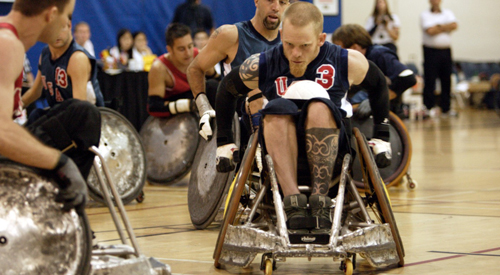
Murderball (2005)
Rating: 10/10
When true stories are adapted for a big screen treatment, it’s usually a hit-or-miss deal. Documentaries, on the other hand, pack much more of an impassioned punch that resonates for a much longer period of time.
Murderball, the documentary at hand about wheelrchair rugby, is a perfect example of how these projects are able to deeply connect an audience while drawing our eyes to the relentless action that takes place in the matches.
The documentary follows the United States murderball team as they prepare for the 2004 Paralympics in Athens. The filmmakers interview three main players, Andy Cohn, Scott Hogsett, and Mark Zupan. These teammates have all been through difficult times; sometimes even before their accident. Zupan’s accident, in particular, was caused by one of his closest friends. Even though Zupan has come to deal with the fact that he will not be able to walk again, his friend is still learning to deal with the tragic event.
The documentary also follows Joe Bishop, an American Murderball veteran who has crossed sides to coach the Canadian team due to previous drama and bad blood. Bishop has a tough exterior which makes it hard for him to relate to his son. Filmmakers Henry Alex Rubin and Dana Adam Shapiro take advantage of this opportunity to tell a story about the father-son relationship that appears to be slowly descending into shambles because of Joe’s dedication to the game.
[php snippet=1]
Murderball is insanely truthful. For instance, the three US teammates talk willingly and in details about how exactly their bodies work post-accident. These details are especially mesmerizing because these are questions that are usually on our minds but we may be too afraid to ask. Scenes that describe the sex life of a paraplegic are insightful but the subjects manage to make certain areas humorous.
The audience is also treated to a detailed look as to how murderball is played and just how much passion each player deposits into each game. Rules are carefully laid out so that an uneducated audience can grasp the subject matter. Once the game blueprints are established, the game becomes even more interesting as we root for Zupan to carry the rugby ball from one side of the court to the other without getting annihilated.
One of the most touching aspects of Murderball is it’s ability to show the game from different perspectives. There are scenes with terrified onlookers watching players get hit, however, we do see how eager fans view the game as well. One individual in particular explains that he’s been recently put in a wheelchair and is intrigued by the murderball mentality. When Zupan helps him into an official murderball chair, we see the newly paralyzed man’s face light up as he’s entered into another world.
In a summer where audiences were more interested in watching documentaries that involved cute, little penguins, Murderball flew under a lot of radars. Hell, I remember being the only one in the theatre watching it. It’s too bad because the film is not only knowledgable about the sport of murderball and the reality of living life in a wheelchair, but the story and the way it’s told makes movie goers feel a variety of different, strong emotions. I cannot recommend Murderball enough.
[php snippet=1]

